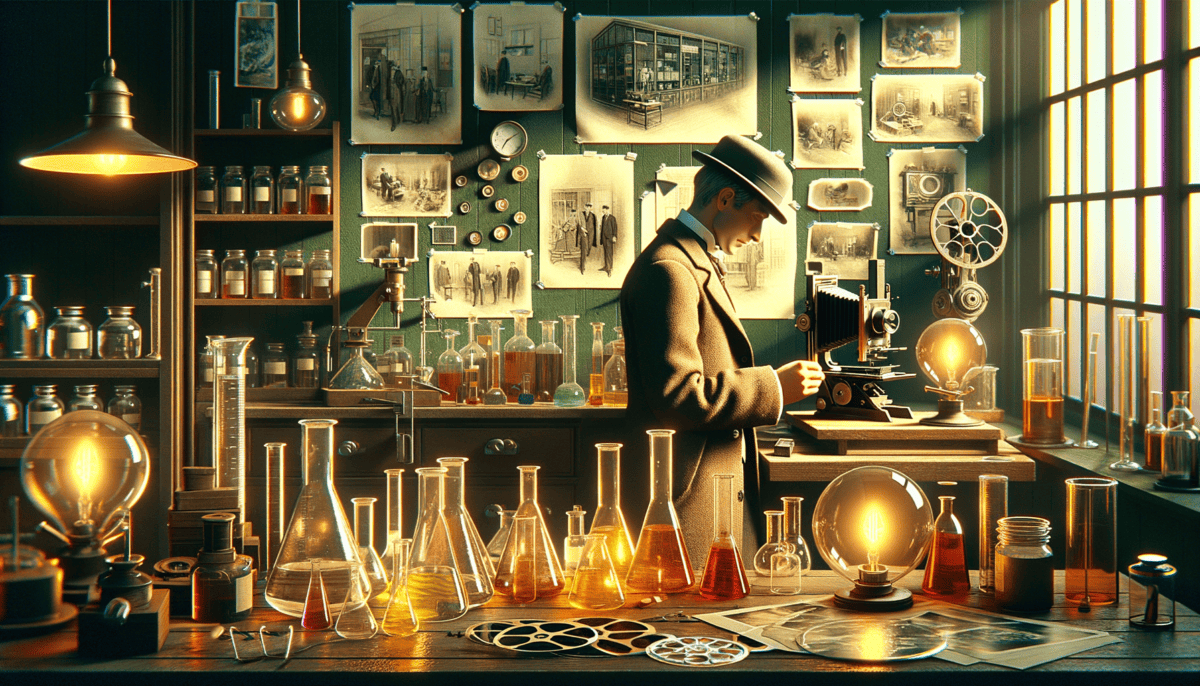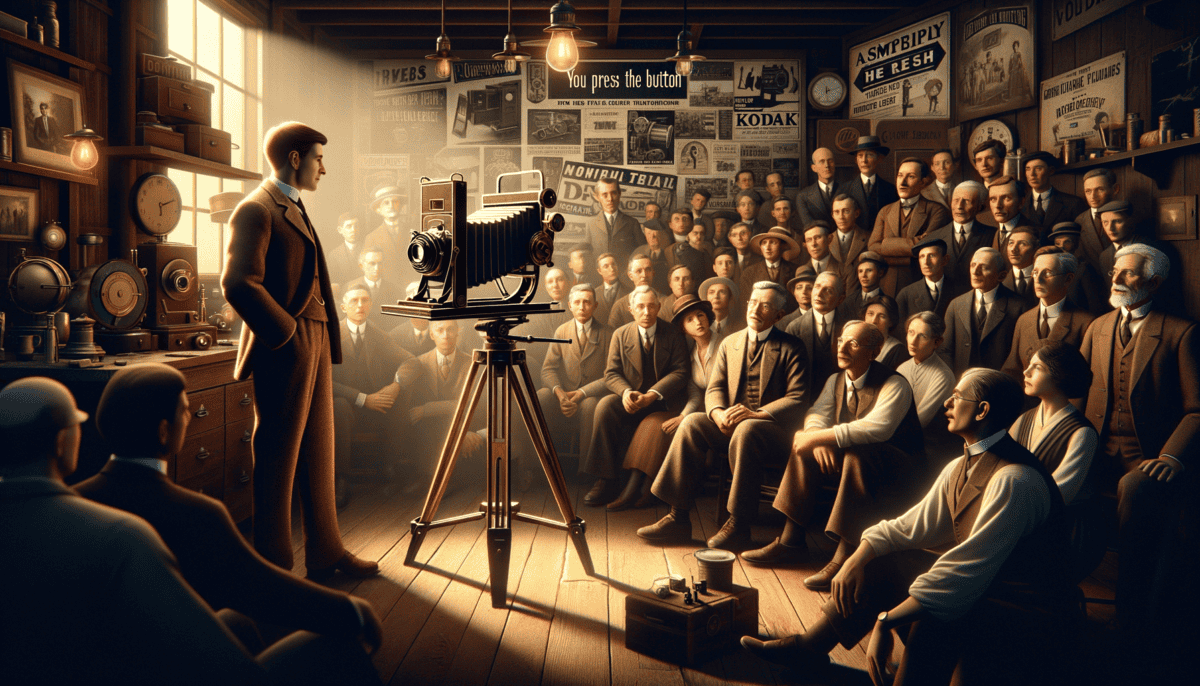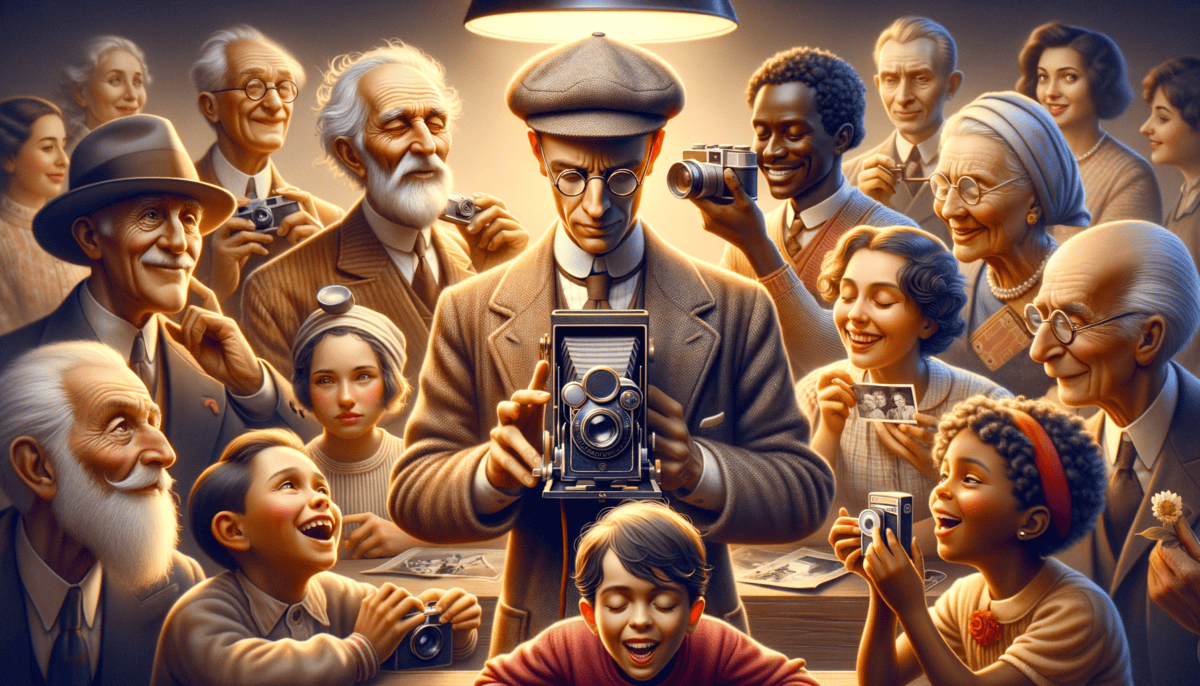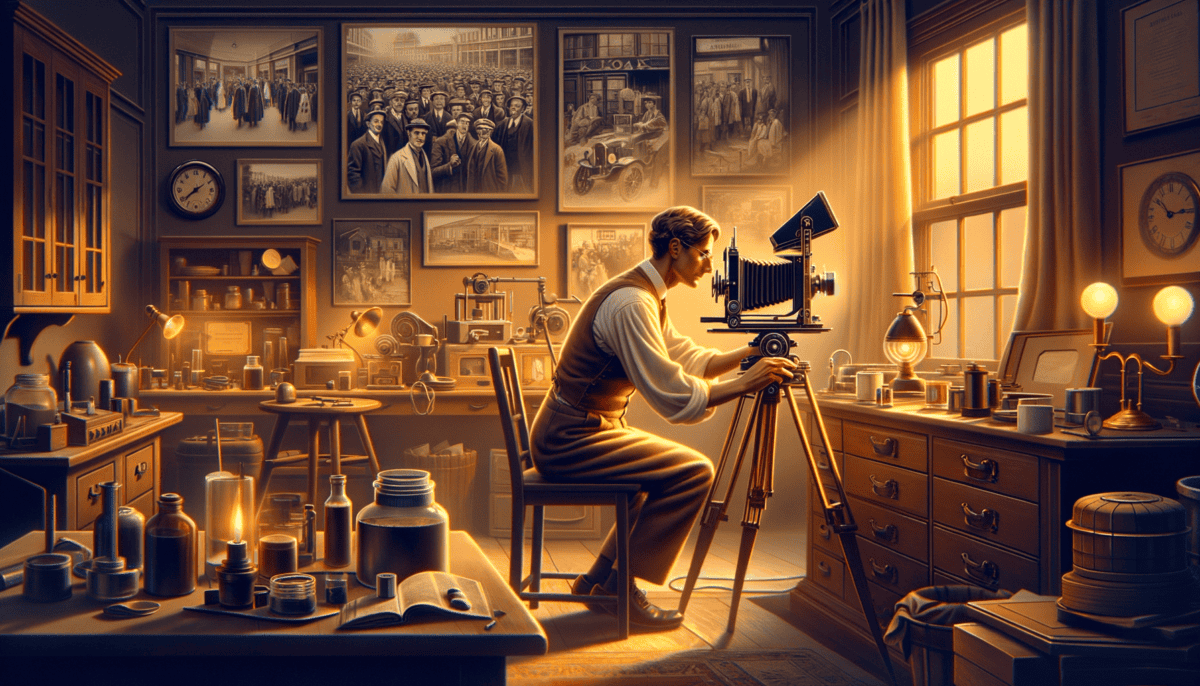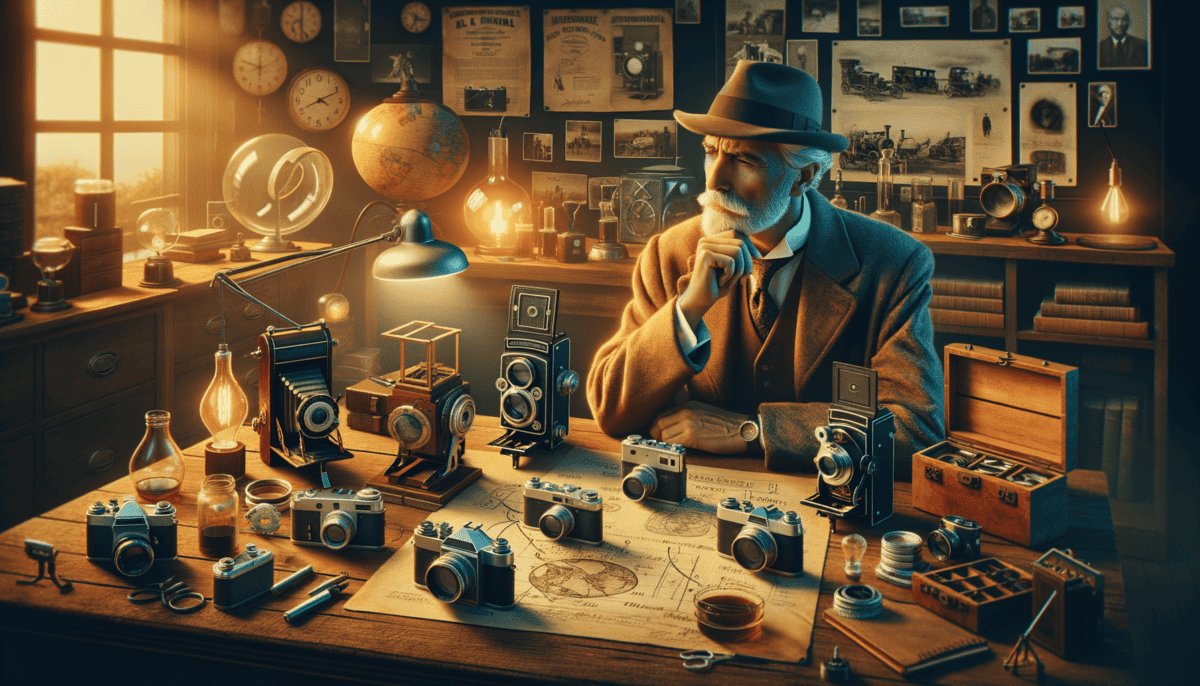The Curious Mind
Little George Eastman peered out his bedroom window in Rochester, New York. The year was 1862, and the world was very different from today.
"George, breakfast is ready!" his mother Maria called from downstairs.
The twelve-year-old boy rushed down, his mind already spinning with ideas. Their home wasn't fancy – his father's business school hadn't done well, and now they had to be careful with money.
"Mother," George said between bites of toast, "I saw Mr. Wilson taking pictures yesterday. It looked like magic!"
Maria smiled. "Photography is quite complicated, dear. The equipment is very expensive, and you need lots of special chemicals."
Key Facts About Young George:
• Born in 1854 in Waterville, New York
• Moved to Rochester when he was young
• Had to leave school at age 14 to work
• Loved learning about new things
George watched the photographers in town struggle with their big, heavy cameras. They needed a wagon just to carry all their equipment! The glass plates they used for pictures were fragile and had to be used right away.
"There has to be a better way," George thought to himself.
At age fourteen, he started working as an office boy at an insurance company. He earned $3 per week. Even though he had to work, George never stopped learning. Every night, he read books about science and business.
One day, while walking home from work, he stopped to watch a photographer set up his equipment. The man had:
A huge wooden camera
Glass plates covered in wet chemicals
A dark tent for preparing the plates
Lots of heavy equipment
"Sir," George asked politely, "why does it take so much stuff just to take one picture?"
The photographer wiped sweat from his forehead. "That's just how photography works, boy. It's not for everyone."
But those words made George think even harder. What if photography could be for everyone?
He saved his money carefully. Photography was expensive – a single picture could cost as much as a week's pay! But George was determined to learn everything about it.
At night, he dreamed of making a camera that anyone could use. One that wouldn't need all those heavy glass plates and dangerous chemicals.
"Someday," he whispered to himself, "I'll find a way to make taking pictures as easy as writing a letter."
The seeds of a great idea were growing in young George's mind. He didn't know it yet, but his curiosity would change the way people saw the world forever.
His mother noticed him sketching camera designs in his notebook. "George," she said softly, "whatever you set your mind to, you can achieve."
Those words would stay with him as he began his great adventure – one that would bring photography to people everywhere. But first, he had much to learn, and many experiments ahead…
Experiments and Breakthroughs
The year was 1877, and George Eastman couldn’t sleep. His mind was full of ideas about photography.
“First, I need to make better photographic plates,” he muttered, scribbling in his notebook by candlelight.
George had turned his mother’s kitchen into a makeshift laboratory. Pots and pans shared space with strange chemicals and glass plates. Maria Eastman watched her son work late into the night.
“Dear, are you sure about this?” she asked, worried about the odd smells coming from her kitchen.
“Yes, Mother! I think I’m close to something important!”
George’s First Experiments:
Making dry plates that could be stored
Testing different chemical mixtures
Finding ways to make plates less breakable
Every morning, George went to work at the bank. But his real work began when he got home. He spent his savings on photography equipment and chemicals.
“Look, Mother!” George exclaimed one evening. “These plates work just as well as the wet ones, but they don’t need to be used right away!”
Word spread about George’s special plates. Other photographers wanted to buy them. Soon, he was making more plates than would fit in his mother’s kitchen.
But George wasn’t satisfied. Glass plates were still heavy and could break easily. He dreamed of something better – something flexible like paper but clear like glass.
“What if,” he wondered aloud, “I could put the chemicals on a roll of film instead of a plate?”
The experiments continued. George tried:
- Paper coated with special chemicals
- Different types of flexible materials
- New ways to make clear, strong film
- Better methods for developing pictures
Sometimes things went wrong. One day, a chemical mixture exploded, covering everything in dark goo!
“George Eastman!” his mother called. “Please tell me my kitchen is still in one piece!”
He laughed, wiping soot from his face. “Don’t worry, Mother. Sometimes mistakes help us learn!”
Finally, after many tries, George created something amazing – a roll of film that worked! It was light, flexible, and didn’t break like glass plates.
“This changes everything,” he whispered, holding up the first successful roll.
But making the film was just the beginning. Now George had an even bigger idea – a camera that anyone could use, not just trained photographers.
He rented a small building on State Street in Rochester. It would become his first real workshop, where he could work on his inventions without worrying about damaging his mother’s kitchen.
“Remember when you said photography was too complicated for everyone?” he asked his mother.
She nodded, stirring soup at the stove – now safely returned to cooking duties.
“Well,” George grinned, “I’m going to change that. Just wait and see!”
✨ Chemical bottles
Notebooks full of ideas
Tools for building cameras
️ Rolls of experimental film
His dream was getting closer. The roll film worked, and now he needed to create a simple camera to use it. George knew his next invention would help bring photography to everyone…
The Kodak Revolution
The sun rose over Rochester as George Eastman stood in his workshop, holding something special. It was 1888, and in his hands was a small, black box – the very first Kodak camera!
“This is it,” George smiled. “A camera anyone can use!”
The camera was simple and light. Inside was George’s special roll of film that could take 100 pictures. But the best part was his new idea about how to use it.
George knew that developing pictures was hard for most people. So he had a brilliant idea – make it easy! When people finished taking their pictures, they would send the whole camera back to his factory.
“We’ll develop the pictures for them,” he explained to his workers. “Then send their camera back with new film, ready to use again!”
People were surprised by this new way of taking pictures:
“But where do I mix the chemicals?” asked one confused photographer.
“You don’t!” George replied with a grin. “Just press the button and send it to us!”
Some professional photographers laughed at George’s simple camera. They didn’t think regular people could take good pictures.
But George believed in his idea. He put this notice in newspapers:
• Takes 100 pictures
• Easy to use
• No messy chemicals
• Perfect for family memories
Soon, something wonderful happened. People who had never taken pictures before started buying Kodak cameras!
“Look, Sarah!” said a happy customer. “I took pictures of our picnic all by myself!”
Every day, more cameras arrived at George’s factory for developing. His workers were busy but excited:
“These pictures show real life!” one worker said, looking at photos of families, pets, and parties. “Not just fancy posed portraits!”
George kept making his cameras better. He made them smaller and easier to use. He gave them fun names like “Brownie” and made them cost less so more people could buy them.
️ Hundreds of rolls of film
Thousands of pictures
Cameras from all over America
One morning, George watched as people lined up outside a camera shop:
“I want to take pictures of my new baby!” one woman said.
“I’m going to photograph my trip to the mountains!” said another.
George smiled. His dream was coming true – regular people were capturing their own special moments. Photography wasn’t just for experts anymore. It was for everyone!
The Kodak revolution had begun, and it would change how people remembered their lives forever. As George watched more cameras leave his factory, he knew this was just the beginning of something much bigger…
Making more cameras
Selling them around the world
Coming up with new ideas to make photography even better
Democratizing Photography
The streets of America were buzzing with excitement in 1889. Everywhere you looked, people were taking pictures with their Kodak cameras!
“Look at my daughter’s first steps!” a proud mother showed her friends the photos. “I caught the moment forever!”
People could now capture their special moments without being photo experts!
George Eastman watched with joy as photography spread across the country. His simple camera was changing how people saved their memories.
“Before, only rich people could have their pictures taken,” George told his friend. “Now everyone can be a photographer!”
In parks, at beaches, and during family gatherings, the familiar click of Kodak cameras could be heard. People were discovering the magic of saving their everyday moments:
• Family picnics
• Birthday parties
• Pets playing
• Holiday celebrations
• Vacation trips
One day, a letter arrived at the Kodak factory:
“Dear Mr. Eastman,
Thanks to your camera, I took pictures of my grandmother’s 80th birthday. Now we’ll always have these memories.
-Jimmy from Ohio”
George smiled as he read more letters. His camera was helping people tell their own stories through pictures.
The Kodak camera wasn’t just popular in America. People all around the world wanted to try it!
“Orders are coming from England, France, and even Japan!” announced George’s secretary.
Schools started using cameras to record class pictures. Newspapers bought them to take photos for their stories. Even scientists used them to document their discoveries!
Made art more accessible
Helped record history
Brought families together
Connected people worldwide
One morning, George visited a local park. He saw children, parents, and grandparents all taking pictures:
“Watch this!” a little boy called to his sister. “I’m going to take your picture on the swing!”
A grandmother nearby was teaching her grandchildren about the camera:
“When I was young, we had to go to a special studio for pictures,” she explained. “Now we can take them anywhere!”
The Kodak camera was doing more than just taking pictures. It was changing how people saw the world. Every moment could now be captured and remembered.
More companies started making cameras too, but they all followed George’s simple idea: make photography easy for everyone.
✨ A regular part of daily life
A way to share special moments
A tool for learning and discovery
As George walked back to his factory that evening, he saw people everywhere with their cameras. His dream of making photography available to everyone was becoming real. And this was just the beginning of how pictures would change the world…
Building a Better World
The year was 1900, and George Eastman’s camera company was growing bigger than he ever imagined!
One morning, George walked through his big factory in Rochester. He smiled as he watched his workers carefully making cameras and film.
“A happy worker makes better products,” George always said. “And happy workers make a better world.”
George did something very special – he shared his company’s success with his workers!
• Free health care
• Extra money for good work
• Safe and clean workplaces
• Time off to rest
“Mr. Eastman,” said Mary, who worked in the film department, “thanks to the money you shared, I could send my daughter to school!”
George beamed with pride. He remembered how hard it was when he had to leave school to help his family. Now he could help others stay in school.
But George didn’t stop there. He wanted to help even more people!
He gave money to build:
✨ New schools
✨ Big libraries
✨ Music halls
✨ Hospitals
One day, a young student named Tommy wrote to George:
“Dear Mr. Eastman,
I can go to college because of your help. When I grow up, I want to help others just like you do!
-Tommy”
George loved getting letters like this. He believed that helping others was just as important as making cameras.
George’s Big Ideas About Business:
Take care of your workers
Share success with others
Help people learn and grow
Make the world better
In the evenings, George would often sit in his garden and think about all the changes he’d seen:
“When I started, I just wanted to make taking pictures easier,” he thought. “Now we’re helping people live better lives too!”
More and more companies started following George’s example. They saw that being kind to workers and helping the community was good for everyone.
The Kodak company kept growing, and George kept finding new ways to help people. His kindness was changing lives, just like his cameras had changed how we see the world.
As the sun set over Rochester, George smiled, knowing that tomorrow would bring new chances to help others and make the world a little better…
A Legacy That Lives On
The winter sun sparkled through George Eastman’s office window in 1932. At 77 years old, he looked at an old Kodak camera on his desk and smiled.
“What a wonderful journey it has been,” George whispered to himself.
Little Tommy, now grown up and working at Kodak, knocked on the door. “Mr. Eastman, look what I found in the archives!”
He held up one of the very first Kodak cameras George had made. Its leather cover was worn, but it still looked beautiful.
George remembered that first camera:
“It was just a simple box with a button. But it changed everything! Now everyone could take pictures and save their special moments.” ️
People all over the world were using Kodak cameras to capture their lives:
✨ Birthday parties
✨ School graduations
✨ Special holidays
“Mr. Eastman,” Tommy said, “my daughter just got her first camera. She loves it just as much as I loved mine when I was little!”
George’s eyes twinkled. His dream had come true – photography wasn’t just for experts anymore. Everyone could tell their story through pictures!
• Easy-to-use cameras for everyone
• Jobs for thousands of people
• Schools and hospitals he helped build
• The joy of capturing memories
That afternoon, George walked through Rochester. Children waved from the school he had helped build. Doctors smiled from the hospital windows. Workers headed home from the Kodak factory, cameras in hand.
“Hello, Mr. Eastman!” called Mrs. Johnson from her porch. “Would you like to see our family album? It’s full of Kodak moments!”
George sat with her, looking through pages of precious memories – all captured because he had made photography simple and fun.
Today, we can take pictures with our phones because George showed us how to make cameras that everyone could use. His ideas made photography part of our everyday lives!
The Kodak company he built kept growing and changing. New kinds of cameras and film were invented. But the most important thing stayed the same – helping people save their special memories.
George’s kindness and clever ideas changed the world in so many ways:
• Workers learned that companies could be kind and fair
• Students got chances to learn and grow
• Communities became stronger and better
Even today, when we take pictures of our happy moments, we’re part of George Eastman’s wonderful story. His dream of making photography easy and fun for everyone lives on in every snapshot we take.
Every picture tells a story, and George Eastman helped us all become storytellers! ✨


